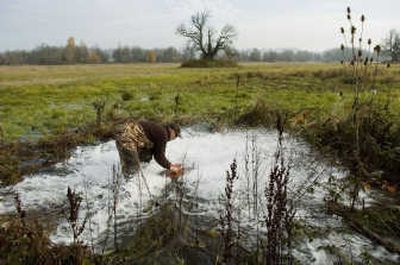Maintenance key at wildlife refuge

RIDGEFIELD, Wash. – You’d scarcely notice while gazing at grebes or eyeing egrets, but Ridgefield National Wildlife Refuge is not strictly “natural” habitat.
To support a wide array of wildlife, the U.S. Fish & Wildlife Service makes use of a dizzying array of ditches, sloughs, lakes, levees and pumps to keep water levels just so. Drain gates and fill gates provide the off-on switch for moving water around the refuge, a low-tech version of the binary system of ones and zeroes that operates computers.
“This is kind of like a maze,” said Jennifer Brown, the refuge manager.
Brown, an East Coast native who moved to the Ridgefield refuge in 2003, defers to veteran refuge maintenance manager Gary McNichols to describe how it all works. Some 50 separate gates and pumps are spread across the River S unit alone, but don’t bother looking for a master map in the visitor kiosks.
“It would be too hard to write it down as a system,” McNichols said.
The fact that the refuge must rely on this system testifies to the extent of mankind’s imprint elsewhere around the Columbia River lowlands, Brown said.
“We’re trying to make up for a lot of lost habitat on a very small acreage,” Brown said.
Two centuries ago, Clark County’s namesake discovered an extreme abundance of wildlife in the marshy lowlands. Capt. William Clark reported trouble sleeping at night due to dull roar of thousands of waterfowl while the Corps of Discovery camped near present-day Vancouver.
“They were immenseley numerous and their noise horrid,” Clark wrote on Nov. 5, 1805.
Dams, dikes and dredging have transformed the Columbia and its lowlands since Lewis and Clark arrived. The present site of the refuge became valuable for agriculture, but only after farmers erected a series of levees and ditches to hold back the Columbia River and move water around for cattle and crops.
The 5,218-acre refuge was established in 1965 to provide winter habitat for the Canada goose. It was a response to the loss of the bird’s northern nesting areas when a subduction-style earthquake dropped large swaths of Alaska shoreline in 1964.
Today, the refuge is once again an important way station for migrating waterfowl. And it requires careful management to keep it that way.
That responsibility falls to McNichols, whose duties sometime require middle-of- the-night visits to pump stations.
Filling one wetland often requires moving water through a series of other wetlands, sloughs and ditches. Four pump stations pull water in, and two – called “expulsion” pumps – bail water out. During heavy rain, the dike-enclosed lowlands can fill up faster than they drain out. McNichols pointed out three float-triggered expulsion pumps arranged in a wooden shack atop a slough on the north end of the River S unit.
Managers must orchestrate water flowing around the refuge in concert with the level of the Columbia River, which rises and falls based on ocean tides and the Army Corps of Engineers. Lately, McNichols has noticed, the corps has been operating its upriver dams in such a way that the Columbia is chronically lower than in years past. A lower river effectively reduces the level of the water table, which, causes wetlands to drain more quickly.
That, in turn, requires more pumping.
In the midst of an unusually dry string of autumn days earlier this month, more than a dozen lakes glistened in the late-morning sun.
“The water that you’re seeing here is the water that Gary has pumped on,” Brown said.
The water not only supports swans, ducks and myriad other creatures; it’s also necessary for hunters who recreate in the River S unit three days a week during the fall season. The water literally draws the hunters’ quarry near the hunting blinds.
“If there is no water near the blinds, they can’t shoot,” Brown said.
McNichols also must battle beavers, which have their own ideas about water management.
“If you want water to flow, they want it to stop,” Brown said. “And if you want it to stop, they want it to flow.”
McNichols acknowledged that the beaver is a native species that’s only doing what comes naturally, and the U.S. Fish & Wildlife Service has no interest in trapping them. Instead, the marauding beavers merely highlight the inescapable irony of managing a wildlife refuge that relies so heavily on human intervention.